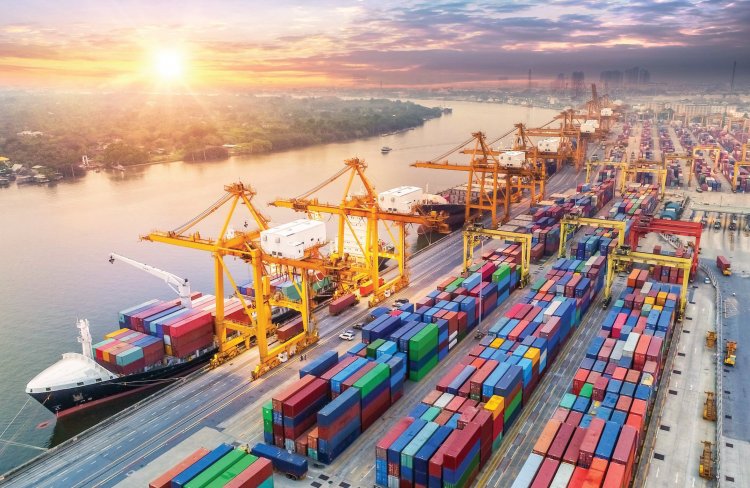Exports on high growth trajectory
Amazon platform, exporter facilitation will accelerate shipments from Pakistan

KARACHI:
A good news first – Pakistan is going to set up the first-ever Amazon Fulfillment and Facilitation Centre in Multan just after Eidul Azha.
It is encouraging because having an Amazon centre in the country means the youth and small and medium enterprises (SMEs) will now be able to sell their products to the entire world via Amazon. This will boost exports.
Pakistan’s merchandise exports in fiscal year 2020-21 grew 18% to $25.3 billion from $21.4 billion a year earlier, according to the Pakistan Bureau of Statistics.
However, imports also surged to $56.3 billion from $44.5 billion a year earlier, leading to a huge trade deficit of $31 billion ($56.3 billion minus $25.3 billion).
Managing such a high trade deficit is obviously difficult. Pakistan needs to accelerate exports further and, at the same time, contain imports of luxurious consumer goods.
Amazon has already added Pakistan to its sellers’ list, which means once the Amazon centre in Multan starts working, the youth and SMEs can immediately begin selling their products to the world.
The resultant increase in export earnings will help accelerate the overall growth of merchandise exports and a sustained, high growth in export earnings will help reduce the trade deficit.
The trade deficit has to be brought under check, and practically speaking, it could be curbed effectively more through increased exports and less through containment of luxurious imports.
The reason is the current free trade regime and World Trade Organisation (WTO) rules and regulations do not leave much room for individual countries to contain import growth via tariff barriers.
The Amazon decision to add Pakistan to its sellers’ list and the setting up of Amazon centre in southern Punjab will also help in boosting services’ exports.
Pakistani entrepreneurs and SMEs can easily sell services’ products to the entire world. This should hopefully augment services’ exports.
In first 11 months of the last fiscal year, the services’ exports brought in $5 billion but services’ imports consumed $8 billion, creating a services’ trade deficit of $3 billion.
This deficit can also be bridged more easily via enhanced exports rather than reduced imports because no developing country, aiming to achieve higher economic growth, can afford to slash imports of services.
Imported services’ products, just like domestically produced services, are required for running the wheels of economy.
External sector
If the Amazon Pakistan platform starts giving early dividends and the resultant increase in both merchandise and services’ exports makes it possible to fix – even partially – the overall trade deficit, it will be ideal. Currently, Pakistan fills this trade gap with remittances from the Pakistani diaspora.
This practice of managing the trade deficit with the diaspora income is dangerous because it hides the structural weakness of Pakistan’s external sector.
The external sector of a developing economy becomes truly healthy only when its total export earnings begin to catch up with the total import spending, and the remittances are used for external debt servicing.
If this does not become the case, then the country remains dependent on additional external borrowing year after year and finally lands in a debt trap.
Debt management, external or domestic, is bound to remain challenging if the fiscal deficit occurs year after year, and the mountain of accumulated debt keeps growing.
The size of accumulated debt and the size of fiscal deficit in a given year are the two key factors that determine the manoeuvrability of debt management tools. Most of the time the government has to decide how much to borrow from domestic markets and how much from external sources.
Without home remittances becoming available for external debt servicing, the government has to rely on additional external borrowing – not just for repaying the old debt, but also to fund the development spending amid the yawning fiscal deficit.
This is also an undeniable fact. And Pakistan has been doing this for over a decade.
It would be sheer optimism to expect that Pakistan’s dependence on external funds to fix its balance of payments would be over during the remaining two years of Pakistan Tehreek-e-Insaf (PTI) government, or even in the next five years of another government.
But if the current enhanced policy focus on exports and remittances remains intact not only during the remaining two years of PTI, but also over the next five-year tenure of the new government, the reliance on external borrowing can be lessened.
Facilitating exports
The establishment of National Export Development Board under the chairmanship of Prime Minister Imran Khan, introduction of Export Facilitation Scheme 2021 and setting up of Amazon Fulfillment and Facilitation Centre are the three major developments that are sure to put Pakistan’s exports on a sustainable high growth trajectory.
The Export Facilitation Scheme 2021 is a forward-looking set of draft rules, governing the export sector and is to be approved by parliament. Even after the passage of the draft rules in parliament, the scheme will run alongside the existing export regime for two years before the existing rules are completely phased out.
The scheme is designed to encourage SMEs to boost their exports, besides making exports easier by large manufacturers-cum-exporters and commercial export houses.
A high growth in exports can be expected once exporters are supported by the new Export Facilitation Scheme, and their performance is monitored and obstacles removed immediately by a powerful National Export Development Board comprising all the relevant line ministries and representatives of the Federation of Pakistan Chambers of Commerce and Industry and the Pakistan Business Council.
In the case of remittances, however, more needs to be done to ensure continued export of Pakistani professionals and skilled workers to foreign countries. That will not be an easy task because two main host countries of Pakistani workforce, ie Saudi Arabia and the UAE, are pursuing policies of localisation of jobs and are likely to continue this drive.
The export of additional workforce to other countries, ie the US and UK, depends a lot on what role Pakistan chooses to play in global politics after the US pullout from Afghanistan.

 Admin
Admin 






























